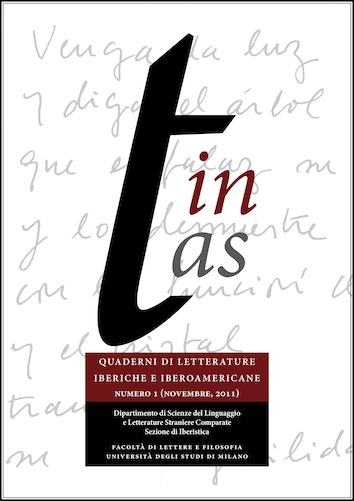Mito e le visioni musicali di Antonio Buero Vallejo
DOI:
https://doi.org/10.13130/2240-5437/1800Abstract
Nel corso della sua attività drammaturgica Antonio Buero Vallejo si confrontò con la scrittura di un unico «libreto para una ópera», intitolato Mito. Il libretto non fu mai musicato, ma venne pubblicato nel 1968 sulle pagine della rivista Primer Acto, preceduto da una breve introduzione dell’autore. Nel 1976, Mito apparve in un’edizione Espasa- Calpe curata da Francisco García Pavón, inseme a La doble historia del Doctor Valmy. Basandosi su quest’ultima pubblicazione, fedele al testo originale, l’articolo indaga la scrittura di Buero, attraverso una sistematica analisi delle didascalie e della costruzione dialogica dell’opera, evidenziando i numerosi suggerimenti musicali del drammaturgo. Dopo una breve introduzione all’opera, si esaminano nel dettaglio gli interventi dell’autore, cercando di rintracciare i diversi ambiti musicali entro cui si muove Buero, per poi arrivare a mostrare la possibile alternanza di un sistema musicale tonale e un sistema musicale dodecafonico. La scrittura musicale sottesa a «Mito» testimonia della spiccata sensibilità del drammaturgo, permettendo di affermare che Buero concepì il testo in forma musicata, fin dalle prime fasi della sua stesura, sostituendosi, in molti casi, all’eventuale compositore, fino a proporre originali e suggestive soluzioni sonore che questo articolo si prefigge di delineare. During his dramatic activity, Antonio Buero Vallejo measured himself with the writing of a single «libreto para una ópera», entitled Mito. This libretto was never set to music, but was published in 1968 in Primer Acto, preceded by a brief introduction of the author. In 1976 Mito appeared in an Espasa-Calpe volume, edited by Francisco García Pavón, together with La doble historia del Doctor Valmy. Based on this edition, true to the original text, the article investigates Buero’s writing through a methodical analysis of the stage directions and the dialogical construction of the text, highlighting the many musical suggestions of the playwright. After a brief introduction to Buero’s work, the article studies in detail the interventions of the author, trying to trace the different musical areas within which Buero moves and finally showing the possible oscillation between a tonal and a dodecaphonic musical system. The musical writing implicit in Mito, attests the strong sensibility of the playwright and allows to say that Buero conceived the libretto as a musical text since the early stages of its composition, taking the place of the composer, in many cases, and getting to suggest original and interesting sound solutions that this article aims to trace out.Dowloads
Pubblicato
2012-01-02
Fascicolo
Sezione
Articoli



